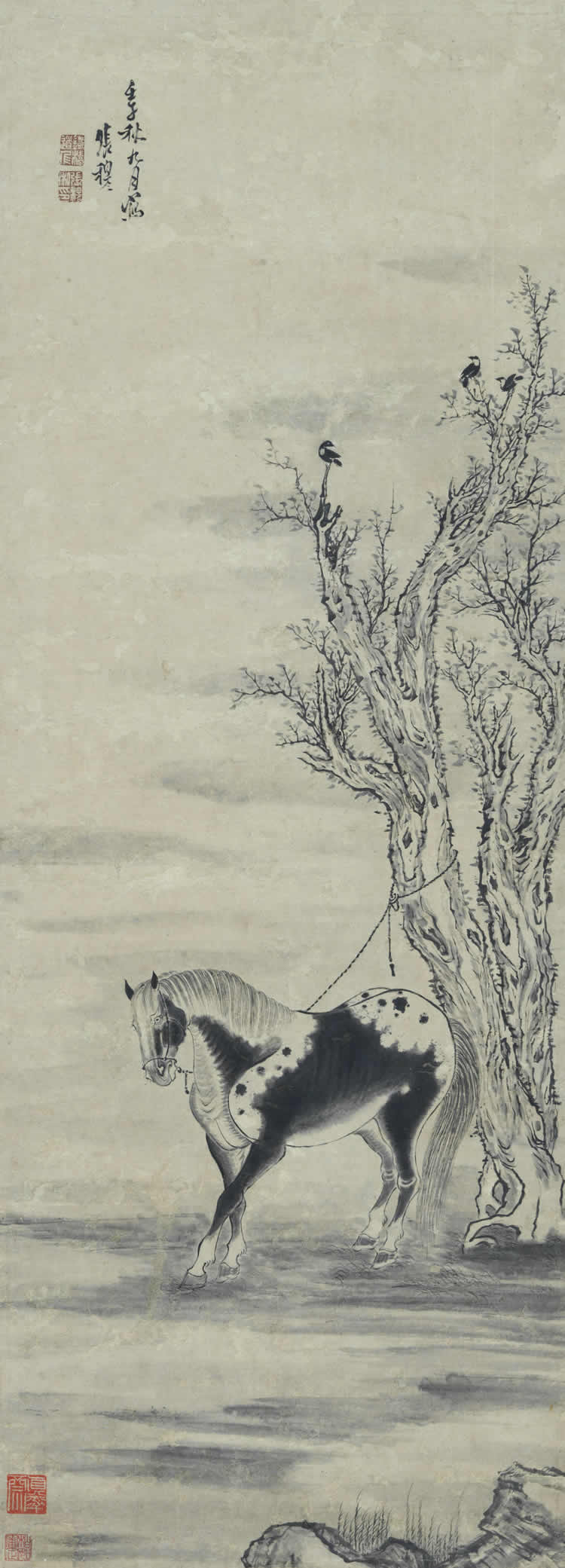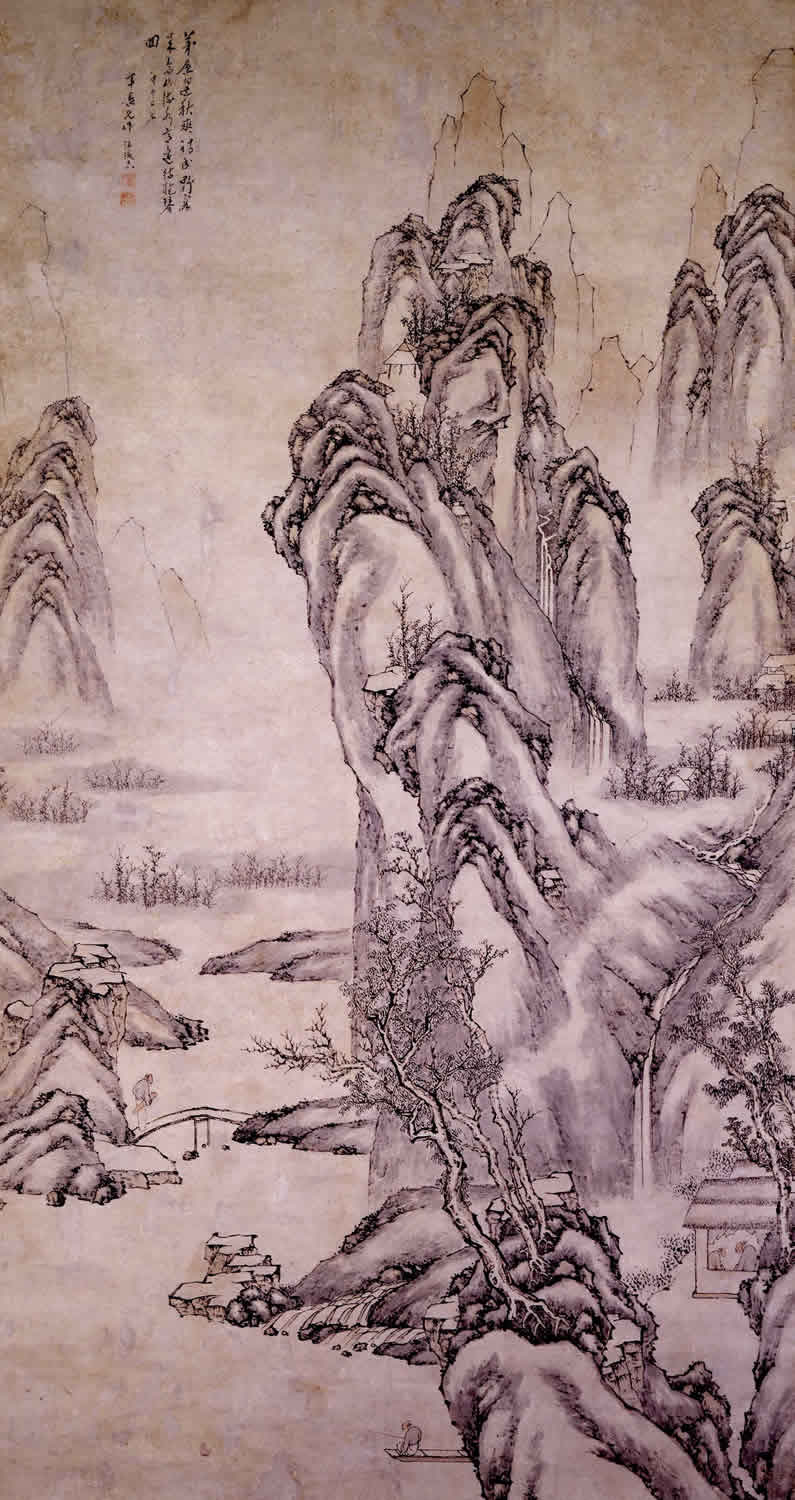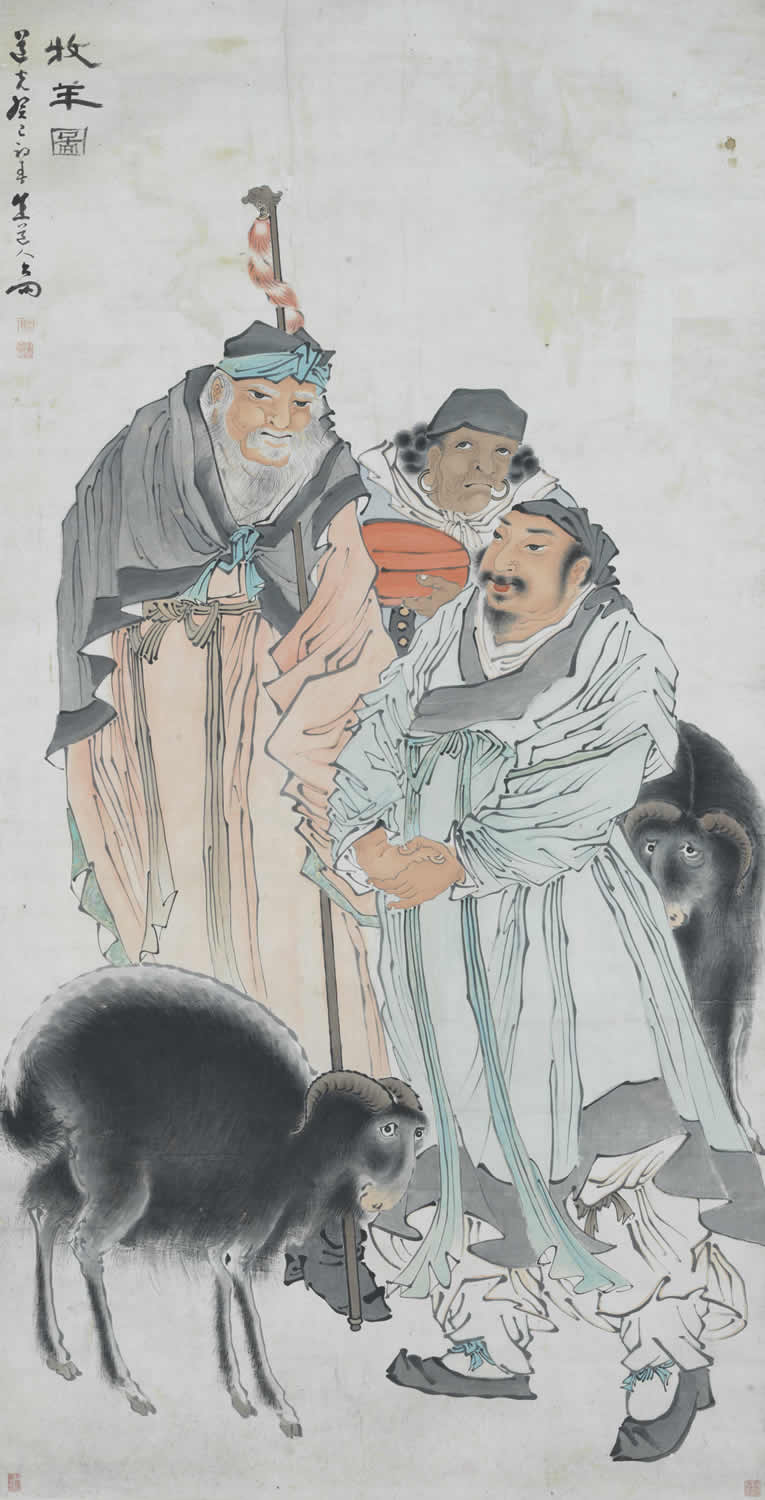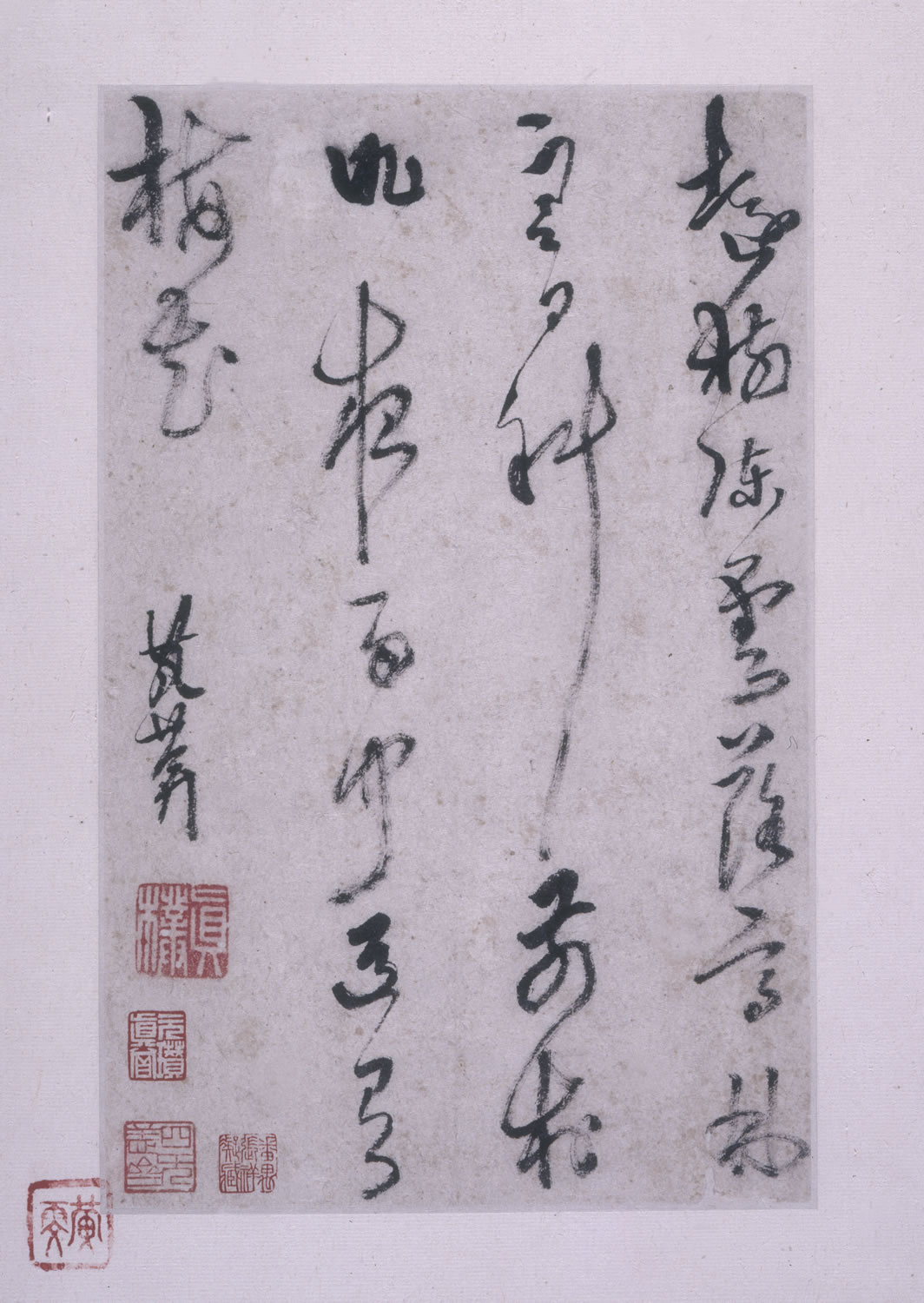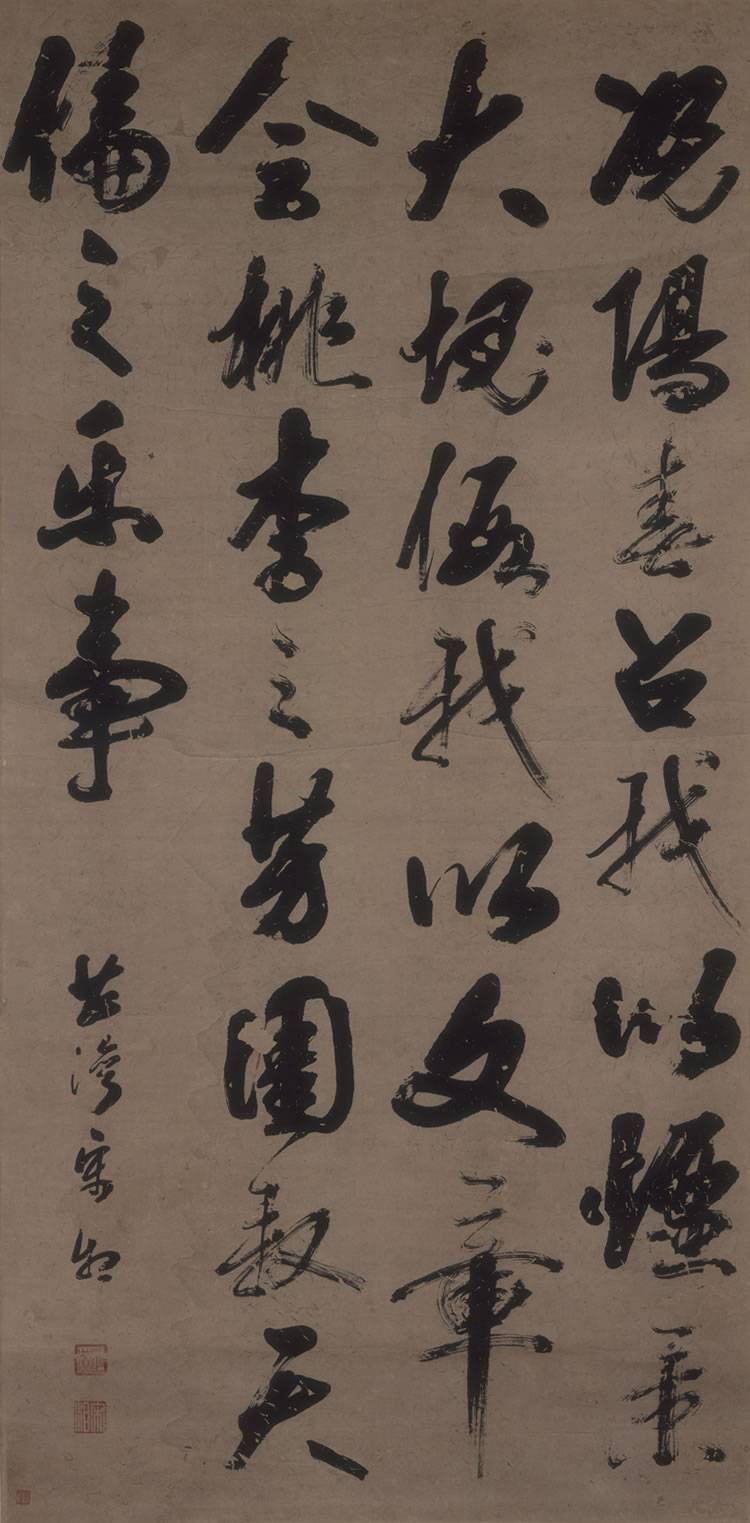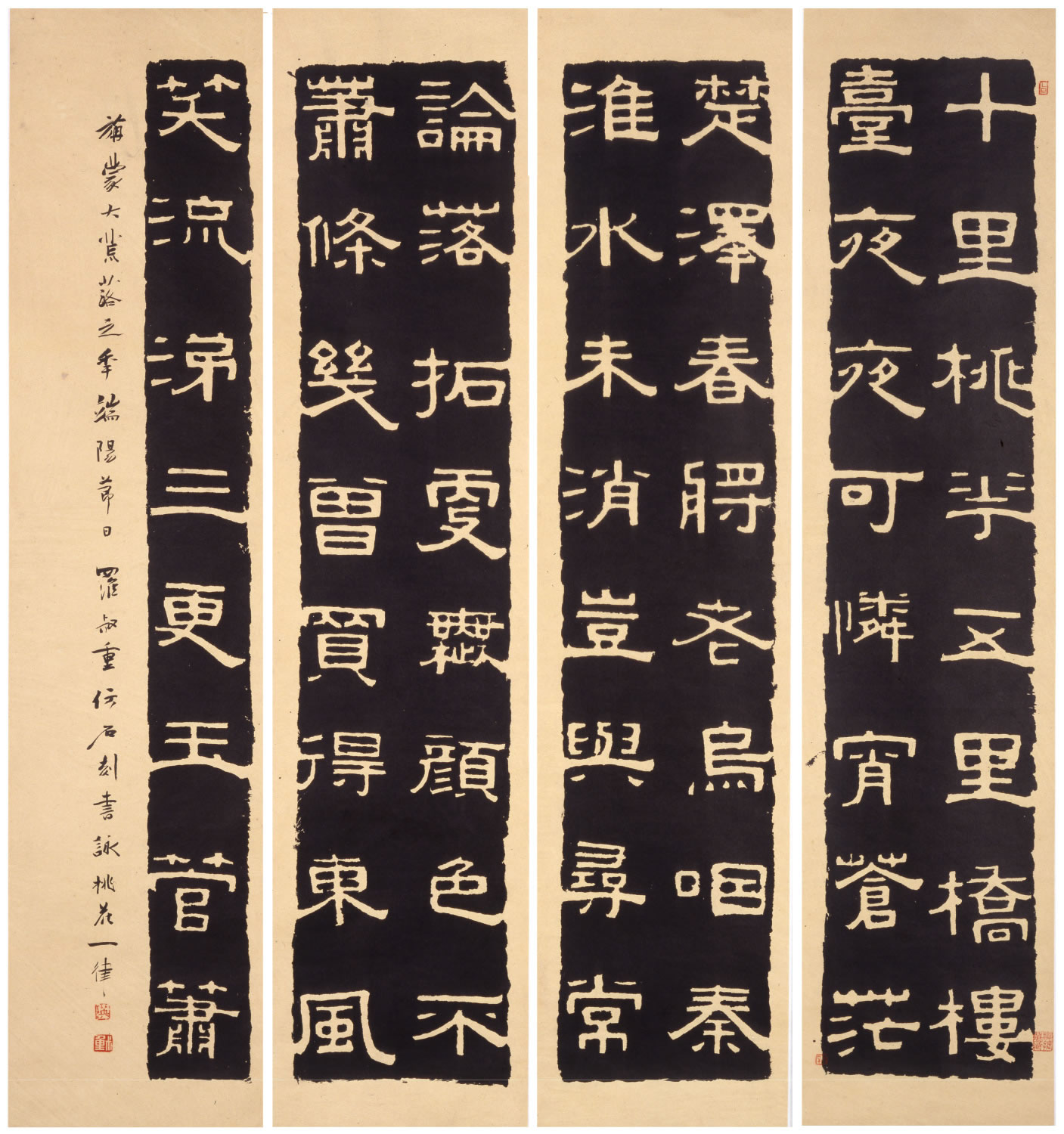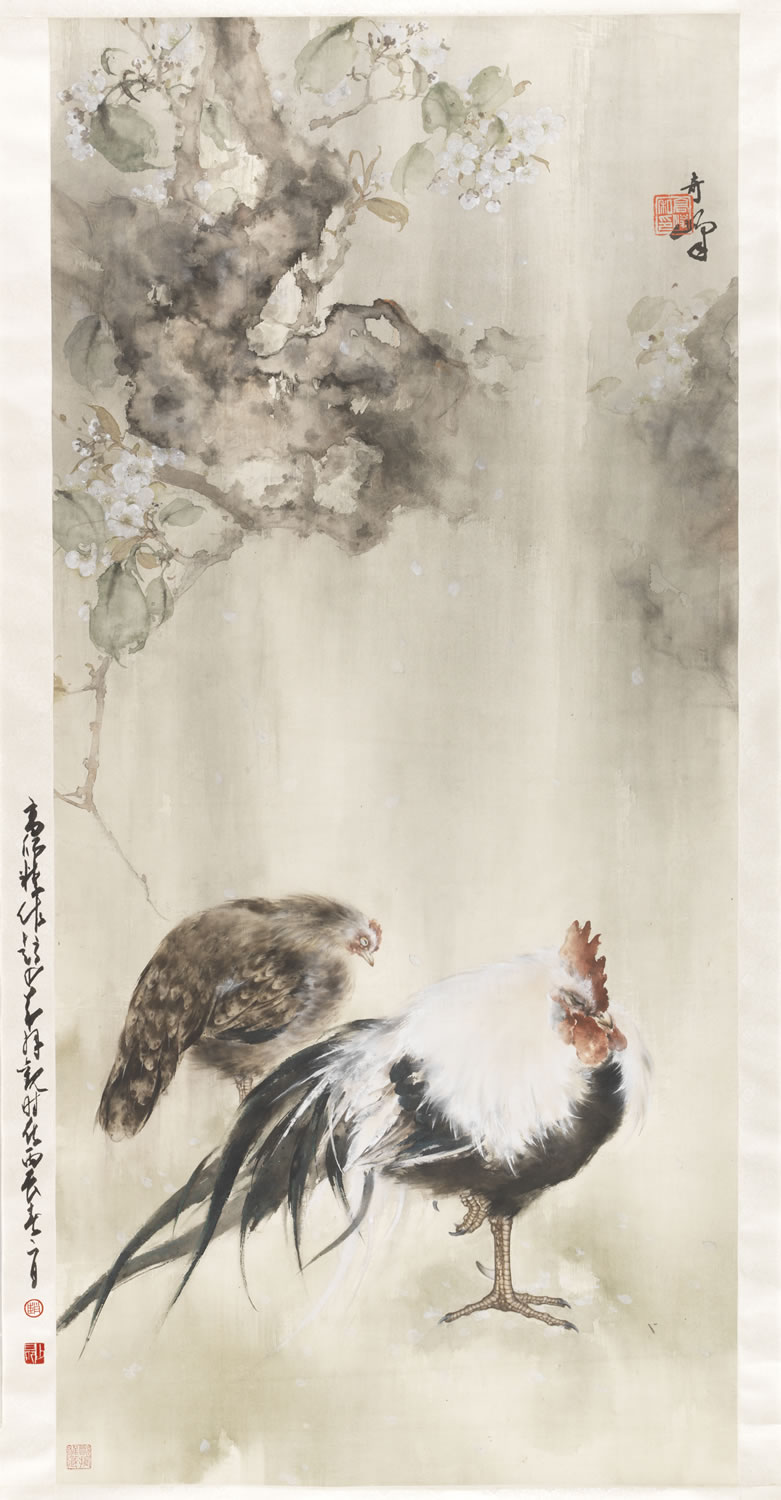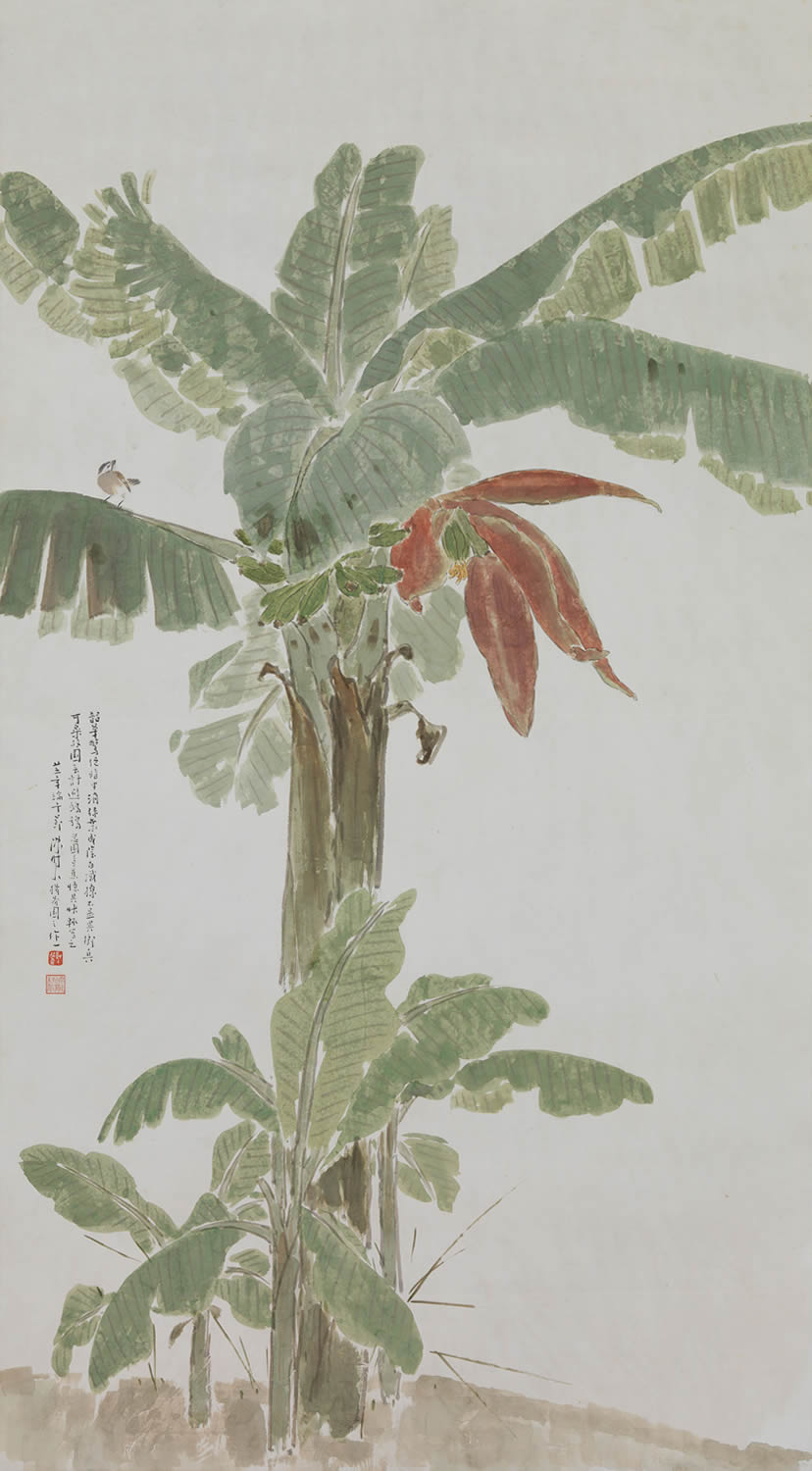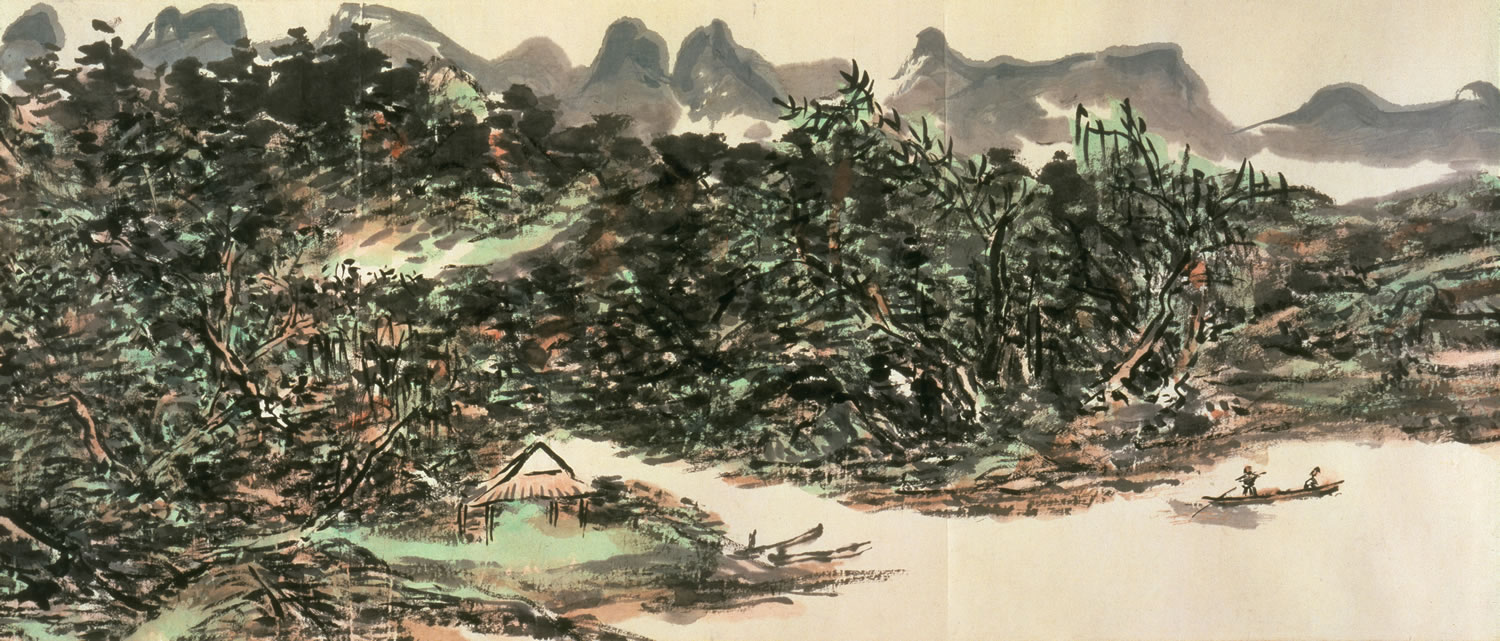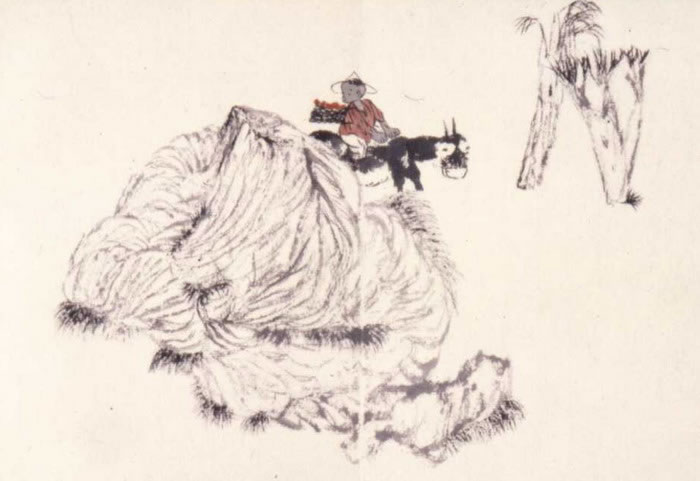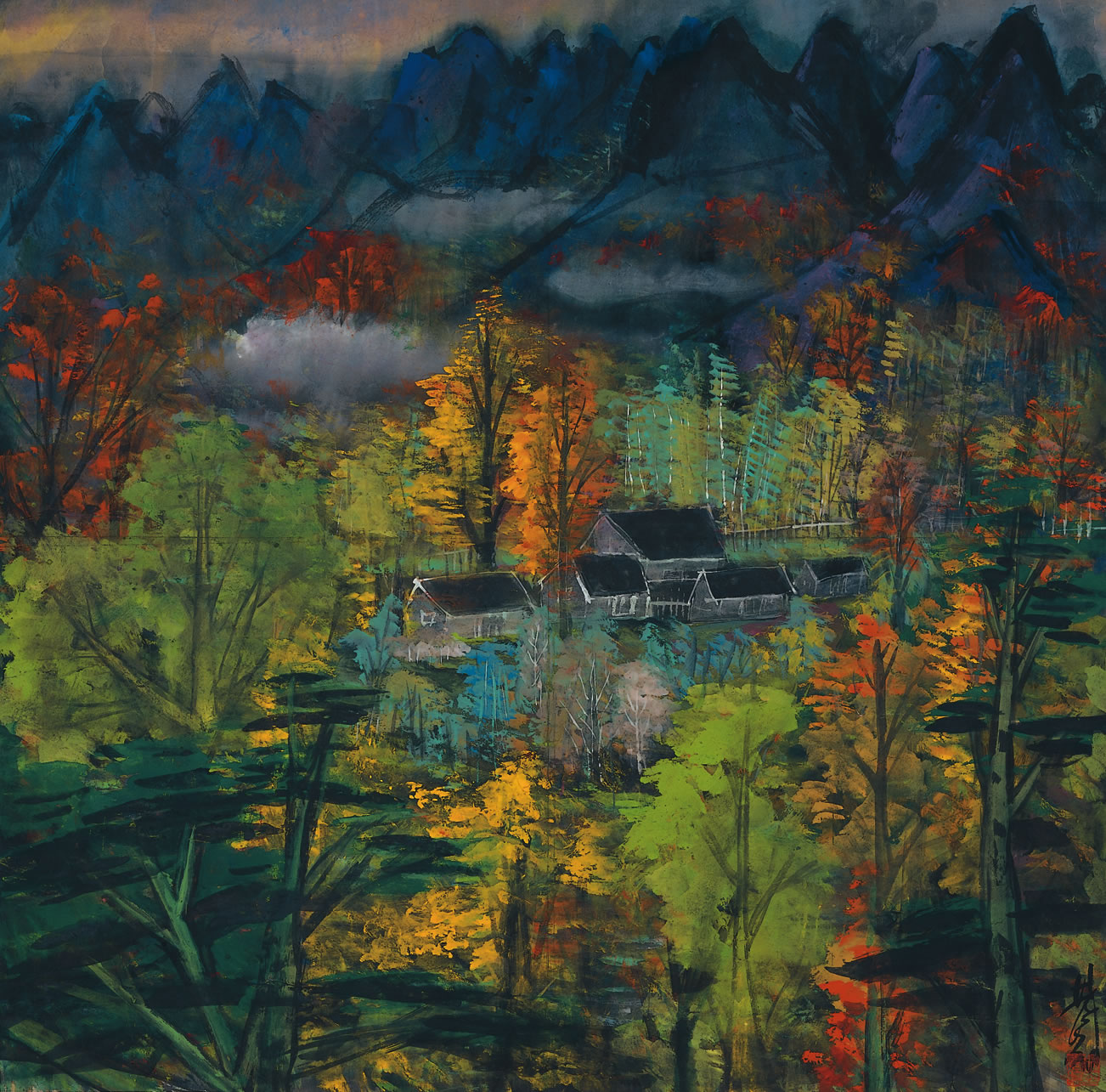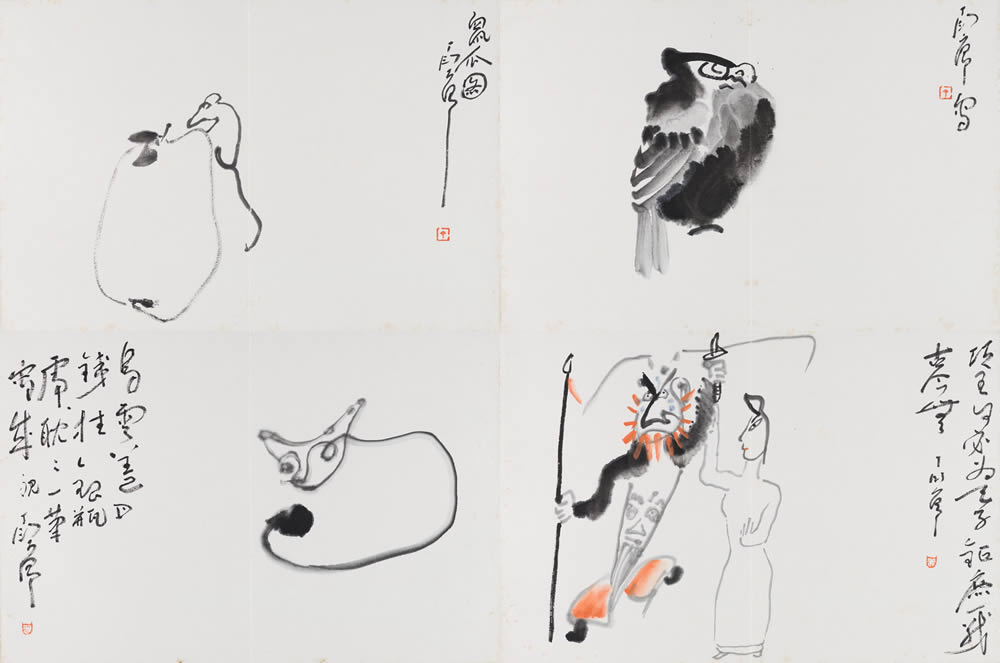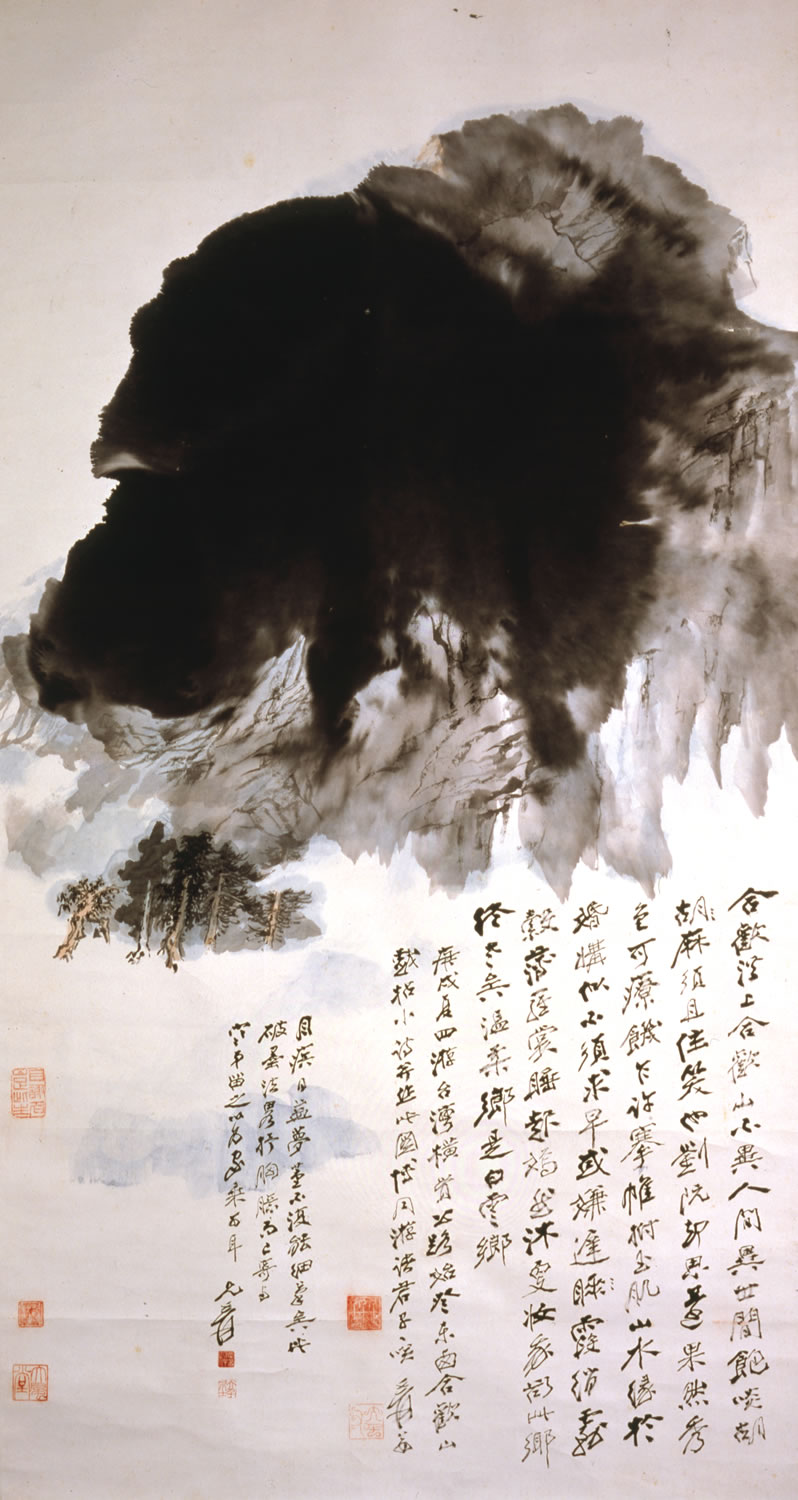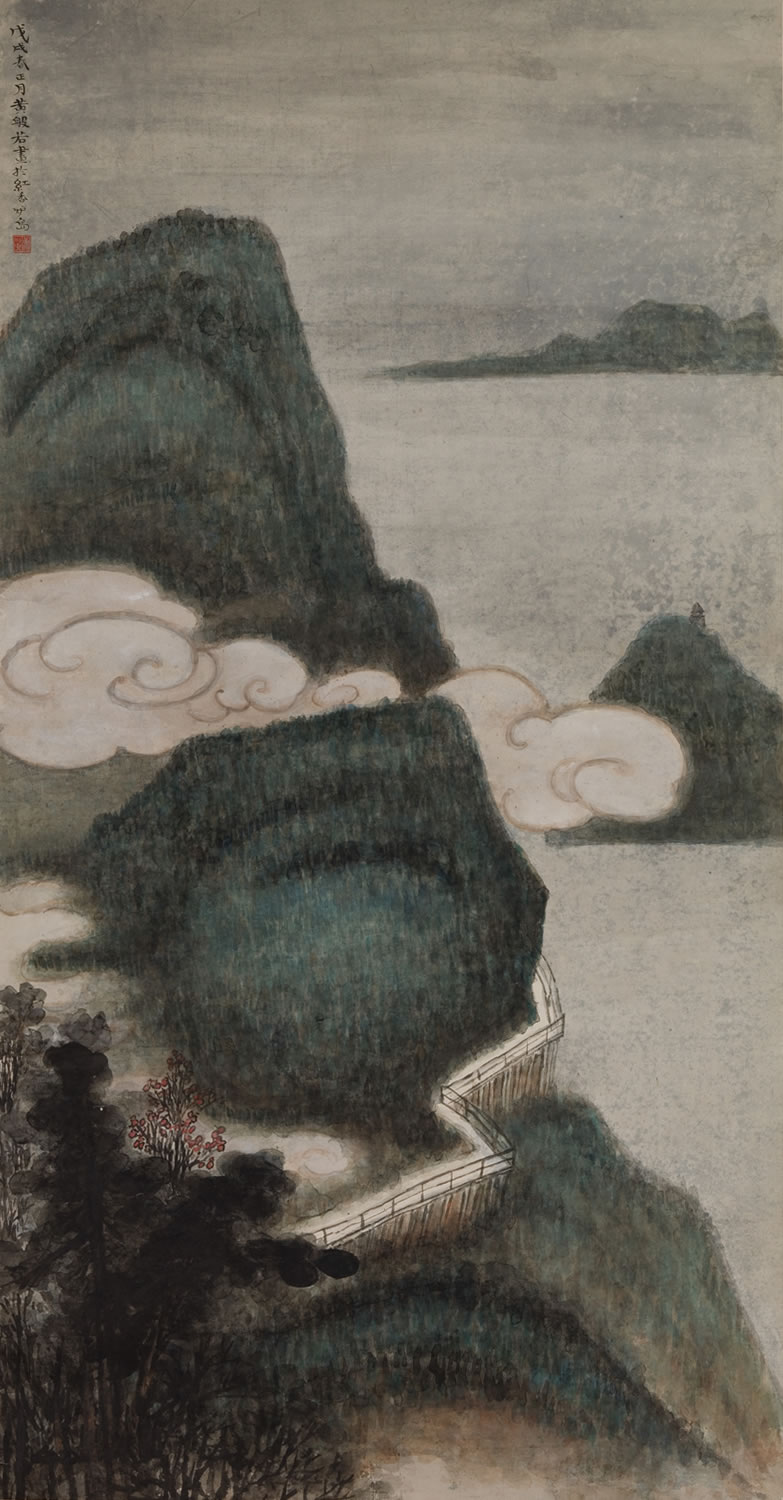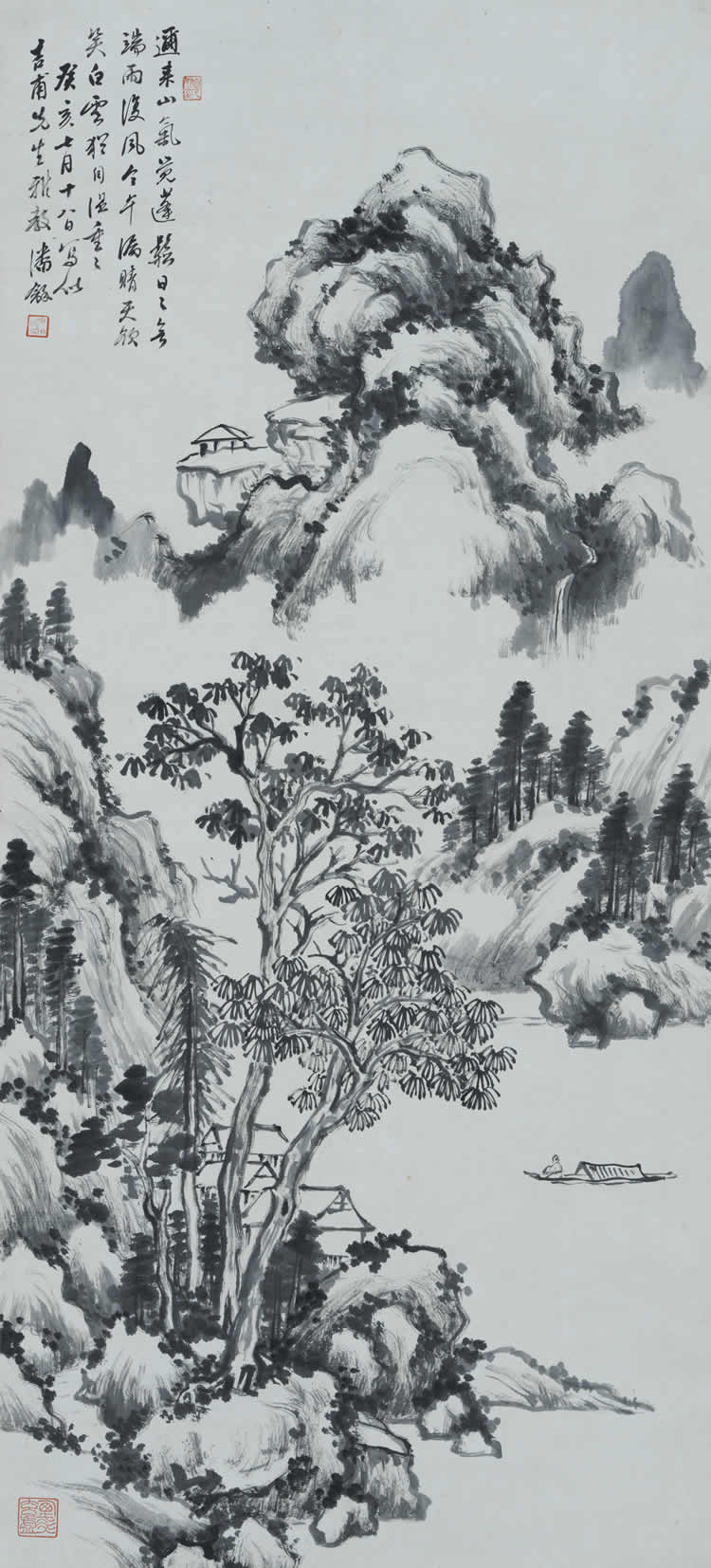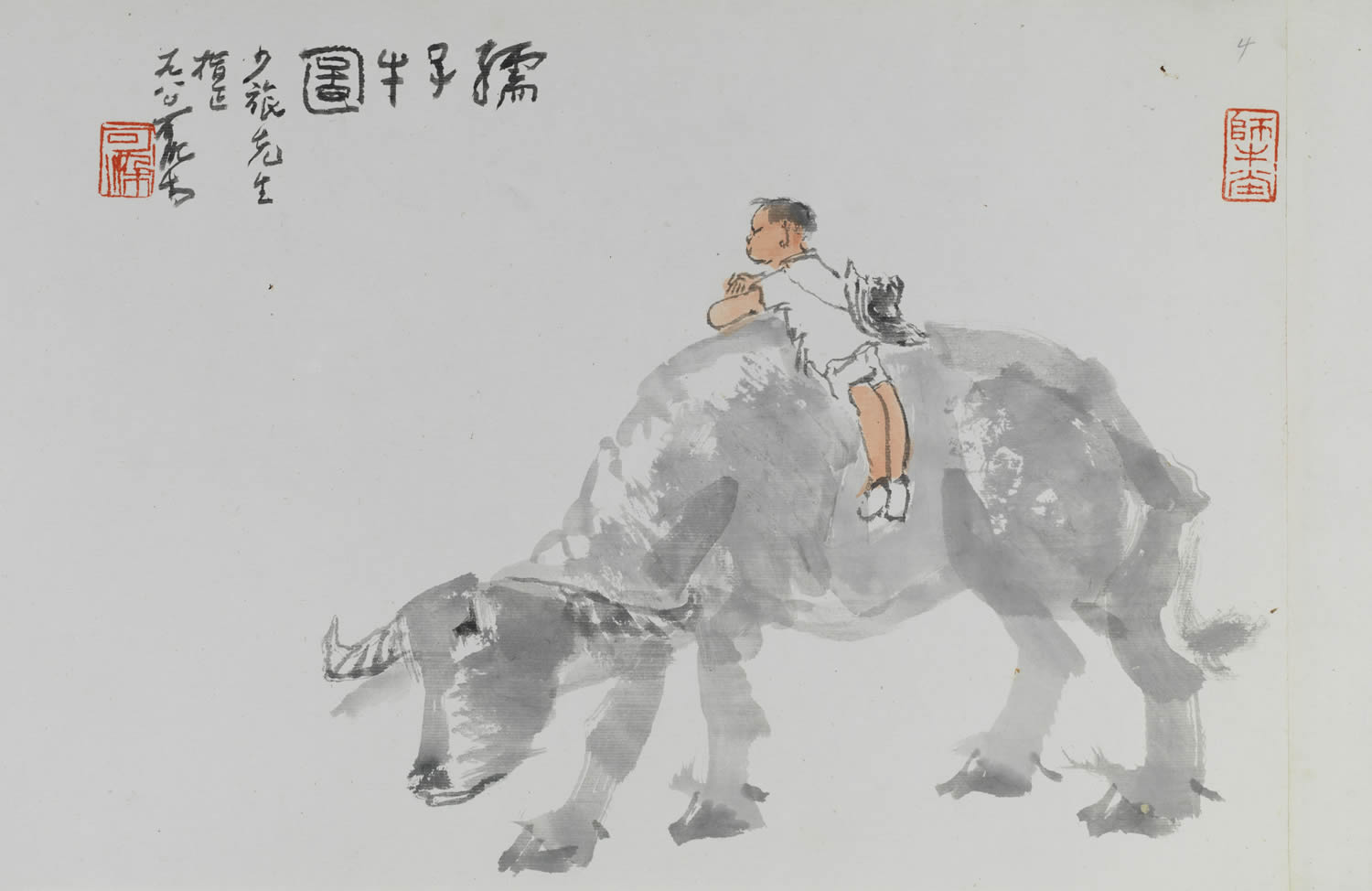 Web Content Display
Web Content Display
Chinese Painting and Calligraphy
The Chinese Painting & Calligraphy collection houses the museum's collection of Guangdong painting and calligraphy and modern Chinese art, the beginnings of which date back to 1964. The rich catalogue of works is the result of many purchases made by the museum itself, but its establishment has also depended on the invaluable support of several collectors, including Mr Huang Bore and Mr Ho Tse-chung's Guangdong paintings, Mr Lau Siu-lui's modern Chinese painting and calligraphy from his Taiyilou Collection, Mr Fan Jia's 20th-century works and Ms Linda Chang's New Literati paintings. These generous donations have immeasurably enhanced the museum's collection, which now comprises over 5,400 works.
The collection is mainly divided into four categories: (1) paintings from Guangdong, (2) calligraphy from Guangdong, (3) the Lingnan School of painting and (4) modern Chinese painting. Representative items from the collection are selected for exhibition to depict how the art of Chinese painting and calligraphy has evolved in Guangdong, with a special focus on developments, also in modern Chinese art, in the 20th century.
Many artists in Guangdong have had an almost innate inclination to modernize. This propensity for change is exemplified in works by artists such as Zhang Mu, Li Jian, Su Renshan and Su Liupeng, whose unique personal styles and alternative modes of expression have served to inspire subsequent generations of artists throughout the 20th century.
Guangdong has also seen the emergence of a succession of talented calligraphers like Chen Xianzhang, Kuang Lu, Song Xiang, Luo Shuzhong, He Shaoji and Jian Jinglun, etc. These artists sketch the development of Guangdong calligraphy from the middle of the Ming dynasty to the present day.
The Lingnan School has played an important role in the development of modern Chinese painting. The artistic origins of the School can be traced back to the Jiansu painters Song Guangbao and Meng Jinyi, who lived in Guangdong during the middle of the Qing dynasty, and their students Ju Chao and Ju Lian, also from Guangdong, in the late Qing. The founders of the Lingnan School, Gao Jianfu, Gao Qifeng and Chen Shuren, advocated a movement for "New Chinese Painting", and their theory and practice of blending Western techniques with Chinese art prompted an enthusiastic and stimulating response.
The impact of the Western tide of art that flooded into China in the 20th century triggered a transformation in modern Chinese art. Many artists tried to learn from Western styles and techniques, while others pursued studies in traditional painting, and these two currents gave birth to a new era in China. The works of Huang Binhong, Zhang Daqian, Lin Fengmian, Wu Guanzhong, Nie Ou and Zhang Yu are characterized by their unique styles that reveal the diverse developments in modern Chinese painting.
-
Horse under a tree
-
Zhang Mu (1607 – 1683)
-
1672
-
Hanging scroll, ink on paper
-
118 x 43 cm
Not only was the horse painter Zhang Mu acclaimed in his native Guangdong region, but he is also awarded high recognition in the mainstream of the history of Chinese painting. Keeping his own stable, he observed his horses closely in order to capture their distinctive characteristics and spirit. In this painting, Horse under a tree, in which a vertical composition is adopted, the horse is portrayed with slender and refined brushstrokes, while the fine definition of the skeleton and the subtle tonal gradation of the horse's coat give a quality of anatomical accuracy. This realistic approach follows the painting tradition developed by famous horse painters such as Han Gan of the Tang dynasty and Li Gonglin of the Northern Song dynasty. -
-
Strolling in Autumn
-
Gao Yan (ca. 1616 – 1687)
-
Not dated
-
Hanging scroll, ink and colour on satin
-
182 x 46 cm
In the early Qing dynasty, the most representative figures of the Guangdong art world were a group of "leftover" literati whose works were full of patriotic sentiment. Among them, Gao Yan was an outstanding painter who was noted for his dry and forceful brushstrokes inspired by the styles of Ni Zan and Shen Zhou, the great masters of the Yuan and Ming dynasties respectively, who provided Gao and his contemporaries not only with artistic models to follow but also with a moral stance to emulate. Gao adopted Ni Zan's style to express his admiration for this master who had refused to serve under the Mongolian conquerors. In the same way, Gao expressed his uncompromising stance through his art–with more than a nod of the head to Ni and Shen–in which he reflected his determination to refuse the summons from the Manchu court and revealed his nationalist fervour.
In Strolling in Autumn, Gao depicts a lonely scholar walking through an autumn forest. The trees with dry leaves in the foreground and the mountain ranges extending horizontally in the background echo the typical schema of Ni Zan's paintings to convey a sense of loneliness, while the forceful brushwork with bold ink dots also reflects the influence of Shen Zhou. From these features, it is easy to imagine the passion of the artist and his admirers who had suffered the fall of their country. -
-
Autumn landscape
-
Wang Houlai (1678 – after 1747)
-
1740
-
Hanging scroll, ink and colour on paper
-
193 x 92 cm
Wang Houlai was the most outstanding figure in Guangdong art in the early Qing dynasty. He served as a military officer and helped to crack down on bandits in his early career, but with his versatile talents he also enjoyed a reputation as a scholar poet who led literati gatherings, and after resigning from his civil post he devoted himself to travelling, reading and painting. This work, Landscape in Autumn, was painted in 1740 where it was stepping into the prosperous age under Qianlong's reign. The mood of desolation and the appearance of the steep mountains are reminiscent of the works of Hongren, who is regarded as the master of the School of Mountain Huang. Wang was originally a native of She District, where Hongren's hometown is also located, and we also know that Wang once travelled to Wuyi Mountain in Fujian where Hongren had lived for many years. The dry brushwork and the light colouring of the texture of the rocks in the hanging scroll allow Wang's artistic roots to be traced back to Hongren. Wang's paintings were also influenced by the styles of Ni Zan, which, however, he treated more as a source of artistic inspiration than as a symbol of disaffection. -
-
Landscape
-
Li Jian (1747 – 1799)
-
1794
-
Hanging scroll, ink and colour on paper
-
195 x 84 cm
Li Jian was a typical literati artist who cultivated the classical arts, especially poetry, calligraphy, painting and seal carving, and he attracted high acclaim in each of these fields. This work, painted after he had recovered from a bout of sickness during a visit to Guangzhou, reveals his versatility both in depicting forms and in using different techniques as he blends the styles of Shitao and Ni Zan. A group of trees is planted in the foreground, while the trees and small cottages in the clearing in the middle of the painting are rendered with a similar degree of richness; the arrangement of dots on the distant mountains is reminiscent of Shitao. Li Jian is credited with establishing the distinctive characteristic of Guangdong painting. -
-
Su Wu herding sheep
-
Su Liupeng (1791 – ca. 1862)
-
1832
-
Hanging scroll, ink and colour on paper
-
234 x 120 cm
Together with another late Qing artist, Su Renshan, Su Liupeng is acclaimed as one of the "Two Sus". Renowned for his figure paintings, his subjects were mostly common people; his works reveal great empathy for the lower classes and also indicate that Guangdong painters were pioneers in portraying the victims of contemporary society. Su Liupeng also painted historical figures and legends, and this painting, Su Wu herding sheep, has a narrative overtone that finds inspiration in the story of Su Wu of Western Han, who lived in the 1st century BC. Sent by Emperor Wu of Han as an envoy to the Xiongnu, Su Wu was held captive by these enemies in the north for nineteen long years. But despite suffering many hardships, he refused to give up his Han identity, and the figure of Su Wu accompanied by his sheep became a popular iconic image of an unyielding hero. This massive hanging scroll portrays this loyal figure in large proportions, yet without making him larger than life. Su Liupeng has used thick outlines in typical, angular brushstrokes, while the realistic rendering of the facial features–which could almost have been taken from life–adds a strong presence to the painting, bringing this historical figure much closer to our own lives and times. -
-
Travellers in the snowy mountains
-
Su Renshan (1814 – ca. 1850)
-
Not dated
-
Hanging scroll, ink on paper
-
125 x 60 cm
Though praised by some modern art historians as "the genius of painting through the ages", Su Renshan found no appreciation among his clansmen because of his eccentric personality. But it is this personality that shaped his artistic style. He began his career by painstakingly studying woodblock-printed painting manuals: in his circumstances it was difficult to gain access to genuine works. Travellers in the snowy mountains is representative of his meticulous style: featuring no colouring, it reveals a close relationship with the style of woodblock prints. In his late years, Su developed a spontaneous style, while also painting more abnormal representations. -
-
Calligraphy in running and cursive scripts
-
Ten Guangdong Loyalists
-
Not dated
-
Album of 10 leaves (selected), ink on paper
-
Each approx. 18.5 x 13.5 cm
The calligraphers in this album of collected works were all loyalists of the late Ming dynasty. Usually scholars or government officials, loyalists were people who were unwilling to serve under the new government after the previous dynastic regime had collapsed and who chose instead to become monks or recluses. The artists featuring in this album include famous poets, calligraphers or painters such as Qu Dajun, Liang Peilan, Chen Gongyin–collectively known as the "Three Masters of Poetry" in Guangdong in the late Ming–Wang Sun and Zhang Mu. The majority of the works are written in running or cursive scripts, revealing the essential characteristics of calligraphy at that time. -
-
Preface to Taoliyuan (Plum and Peach Garden) by Li Bai in running script
-
Song Xiang (1756 – 1826)
-
Not dated
-
Hanging scroll, ink on paper,
-
176.8 x 87 cm
Calligraphers in the Guangdong region often attempted to break away from traditional boundaries and establish their own artistic styles. Chen Xianzhang was well known among his contemporaries in Guangdong in the middle of the Ming dynasty as a calligrapher who invented a new writing instrument that made use of straw to create a personalised brush. In the early Qing, Song Xiang, another famous calligrapher, followed the pioneering trend initiated by Chen, boldly executing his works by means of bamboo leafs or sugar cane brushes; he also followed the cursive script calligraphic styles of Li Yong and Mi Fu. In this work in which Song transcribes the poem Preface to Taoliyuan (Plum and Peach Garden) composed by Li Bai, his lines are filled with a vigorous strength and rhythm. Though Song might not necessarily have employed personalised brushes to complete this work, the heroic stance of the calligrapher is revealed in the composition and the fluency of this hanging scroll. -
-
Calligraphy in running script
-
He Shaoji (1799 – 1873)
-
Not dated
-
Set of 4 hanging scrolls, ink on paper
-
Each 167 x 47 cm
The large number of ancient steles excavated during the late Qing period generated a boom in the study of the scripts used on them. He Shaoji, an official of the late Qing, incorporated the ancient, rhythmic characteristics of the steles' inscriptions with the bold and energetic quality displayed in the works of the renowned Tang calligrapher Yan Zheqing. This fusion was commented upon by a Qing critic, who compared He Shaoji's calligraphy to competing wrestlers and a galloping horse brought to a sudden halt: the wrestlers reveal the rhythmic flow of powerful energy, while the horse, galloping freely at first, is abruptly reined in by his rider. The critic went on to say that only those familiar with the writing of diverse forms of scripts could grasp the essence of He's calligraphy. -
-
Poem on peach blossoms in clerical script
-
Luo Shuzhong (1898 – 1969)
-
1965
-
Set of 4 hanging scrolls, ink on paper
-
Each 130 x 30 cm
Luo Shuzhong, who lived in Hong Kong in his later years, excelled in wonderfully diverse forms of scripts. The characteristics of his clerical script are derived from the inscriptions on the steles of the Northern dynasties, but unlike the rhythmic approach adopted by He Shaoji, he followed the orderly quality of the calligraphy. Luo is credited with the invention of the "black tiger" style, which requires a higher degree of spatial co-ordination and actually imitates the effect of ink rubbing. Achieved by filling the void space with ink to highlight the characters, the "black tiger" style reverses the traditional spatial concept of Chinese calligraphy. -
-
A hundred flowers
-
Ju Lian (1828 – 1904)
-
1875
-
Handscroll (section), ink and colour on silk
-
36.5 x 617 cm
Ju Lian, courtesy name Guquan, studied painting under his cousin Ju Chao. One of the masterpieces among his extant works, A hundred flowers, a monumental handscroll measuring over six hundred centimetres, is a comprehensive composition that is exquisitely executed and meticulously coloured with vividly depicted flowers. The elegant bird-and flower tradition, which prospered at the Song Painting Academy, was first refined by Chen Chun (1483-1544) and further enhanced by Ju Lian using a method known as water and pigment infusion, a special technique that he himself developed. Taking the traditional boneless method as his basis, Ju deposited water and pigment onto the wet painted surface, and this then dried to form a clearly defined boundary, similar to the effect gained with the outline method. A hundred flowers is one of the best examples of this technique. -
-
The Five-storeyed Pavilion
-
Gao Jianfu (1879 – 1951)
-
1926
-
Hanging scroll, ink and colour on paper
-
80 x 42 cm
Gao Jiangfu, original name Lun, courtesy name Jueting, was a native of Panyu in Guangdong province and is credited as one of the "Three Masters of the Lingnan School". He learnt painting with Ju Lian in his early years and then studied in Japan, where he was influence by the Japanese mater Takeuchi Seiho. This historical building in Guangzhou, commonly known as the Five-Storeyed Pavilion, was originally a watchtower built on the city wall in the 14th century. It was destroyed and rebuilt many times over the past 600 years and in 1926 when this painting was finished it was in ruins. The painting is executed with vigorous and rough brushstrokes which differ from those of traditional techniques. Gao used atmospheric effects learnt during his time in Japan, depicting the building at sunset to express his melancholic feeling at passing time and decay. He inscribed on the painting these words: "After endless devastation, this pavilion has turned into a desolate ruin with nothing left but overgrowing weeds and smoke in the fading sunset." -
-
Rooster and hen in spring rain
-
Gao Qifeng (1889 – 1933)
-
Not dated
-
Hanging scroll, ink and colour on paper
-
139 x 65 cm
A native of Panyu in Guangdong province, Gao Qifeng, original name Weng, was the younger brother of Gao Jianfu, with whom he learned painting in his early years before also going to Japan, in 1907, to study under Tanaka Raisho. He is also acclaimed as one of the "Three Masters of the Lingnan School ". This painting is one of the finest examples of Gao Qifeng's work. A couple of chickens are depicted sheltering peacefully under a birch-leaf pear tree. Falling petals and a colour-washed background, together with the two resting chickens, create a romantic, poetic and dream-like visual impact. Exquisitely executed, the chickens and the birch-leaf pear are vivid and solid, yet the artist is able to capture a transient moment of nature. Gao successfully combined the poetic element of Chinese painting, Japanese plein-air painting and Western techniques to develop a unique personal style. -
-
Banana tree
-
Chen Shuren (1884 – 1948)
-
1936
-
Hanging scroll, ink and colour on paper
-
175 x 94.8 cm
Chen Shuren, original name Shao, literary name De'an Laoren or Ershan Shanqiao, was a native of Panyu in Guangdong province. As one of the "Three Masters of the Lingnan School", he learned painting under Ju Lian in his early years and later pursued his studies in Japan. The banana tree has always been a perfect subject for expressing the subtlety of ink and brushwork, but this hanging scroll by Chen differs from more traditional paintings thanks to its spontaneous use of charming colours and the application of a Western perspective. Although working with a simplified form, Chen is still able to capture the essence of the tree, as he contrasts a small bird resting on a branch with the large banana tree and its central setting in the composition. Chen's simple and spontaneous personal style makes him the most lyrical literati artist of the "Three Masters of the Lingnan School". -
-
Crisp air in mountains and lakes
-
Huang Binhong (1865 – 1955)
-
1951
-
Handscroll (section), ink and colour on paper
-
30.6 x 300 cm
-
Donated by The Friends of the Hong Kong Museum of Art
A native of She county in Anhui province, Huang Binhong, original name Zhi, courtesy name Pucun or Yuxiang, showed a passionate interest in painting from an early age. The handscroll Crisp air in mountains and lakes was executed in 1951 when he was 88 years old and his eyesight was seriously impaired by cataracts, but despite this handicap Huang gives great substance to the visual effect by rendering the painting with dark and dense ink. As in abstract expressionism, the intermingling of ink and water is charged with expressive characteristics. Huang successfully applies the traditional techniques of "ink accumulation" and "overnight ink" to create the heavy, foreboding mountains, which are highlighted by dots of mineral green and very dark ink. Densely packed brushstrokes conjure a blurred vision of natural forms, creating the effect of what Shitao called "boundless heaven and earth in masses of dark ink". -
-
Village life
-
Nie Ou (1948 – )
-
Not dated
-
Album of 14 leaves (selected), ink and colour on paper
-
Each 22.5 x 32.5 cm
A native of Shenyang in Liaoning province, Nie Ou studied the free and spontaneous style of figure painting under Li Keran, Ye Qianyu and Li Kuchan, before going on to excel in ink painting and picture books. Forced to live in the countryside during the Cultural Revolution, she was deeply moved by the simple life she encountered there and has since derived much inspiration for her subsequent painting career from her experiences of village life. In this painting, she returns to her favourite subject to present a vision of harmony, as her casually executed brushstrokes and freely rendered images of peasants, trees and animals create a rustic and simple atmosphere. -
-
Light of spirit series (No. 49): The floating sphere
-
Zhang Yu (1959 – )
-
1996
-
Vertical scroll, ink on paper,
-
178 x 96 cm
A native of Tianjin, Zhang Yu graduated from the Tianjin Academy of Arts and Crafts in 1988. As an avant-garde Chinese artist, he uses Chinese ink and paper as the major media for his experimental creativity. By exploring the spirituality of the materials, he re-examines and re-posits the role of traditional techniques, thus extending Chinese ink painting to new horizons. In his Light of Spirit Series, a new schema is applied to bridge the gap between Chinese and Western painting. Zhang retains the traditional format of Chinese paintings in this scroll, yet transmutes the simple and recognisable forms into a textual feature. The visual expression in this work reflects not only Zhang's interest in traditional Chinese philosophy, but also his ambition to reconstruct fragmentary reality, thus revealing his consideration of humankind's ultimate concerns. -
-
Autumn landscape
-
Lin Fengmian (1900 – 1991)
-
1977 – 1978
-
Square scroll, ink and colour on paper
-
67.5 x 68 cm
Born in 1900, Lin Fengmian was contemporary with the 20th century. He went to France in 1919 and later graduated from L'Ecole Nationale Supérieure des Beaux-Arts de Paris. In 1926, he returned to China to become the Director of National Beijing Fine Art School and founded The National Academy of Art, which is the predecessor of the China Academy of Art, in Hangzhou in 1928. During the Sino-Japanese War, he went to Chongqing, and after the War, he moved to Shanghai where he lived alone and led a frugal life painting. He spent four years behind bars during the Cultural Revolution for no justified cause, which also saw the destruction of all his paintings. He resettled in Hong Kong during the later years, where he led a reclusive life. But that was also his most prolific years. Lin not only added an important chapter to the history of Chinese art as an artist, but had also cast seminal influence on later great artists like Li Keran, Wu Guanzhong, Zao Wou-ki and Zhu Dequn. He was therefore highly esteemed as an epoch-making master of Chinese painting.
By using the square frame for his landscapes, Lin established a new presentation format that was quite different from the Chinese traditional landscape paintings, which had invariably been on scrolls. He also favoured a backlight treatment for his landscapes. In this painting, he first applies a background of black wash. Then he dots on the ochre shades of autumn foliage, and adds a touch of peacock blue and mauve on the undulating line suggesting distant mountains. It is his exploration of improving the values of colour against light in Chinese painting, in another attempt at merging Chinese and Western painting techniques. Autumn landscapes like this were inspired by a trip to Tianpingshan in Suzhou in 1953, after which Lin expressly told his students that he wanted to create "new landscapes", and scenes of autumn featured highly in his oeuvre.
This one was done after Lin settled in Hong Kong. In it, we can see although he retains his favourite square frame and the use of perspective for the country homestead amongst autumn woods, the meticulousness of the 1950's up to the 1970's has given way to total abandon expressed in splashes of colours. -
-
After a good nap
-
Ding Yanyong (1902 – 1978)
-
1977
-
Double-sided album of 16 double leaves (leaves 5, 7, 9, 12), ink and colour on paper
-
Each 40 x 60.7 cm
-
Donated by Mr Wong Yi
Ding Yanyong went to Japan in 1920 to study western painting at the Tokyo Fine Arts School. He was passionately attracted to the art of Matisse and the Fauves. When he returned to China, he actively engaged himself in the making and teaching of art. Ding resettled in Hong Kong in 1949. In 1956, he was one of the initiators of the art programme of the New Asia College, which later evolved into the Department of Fine Arts of the Chinese University of Hong Kong. He remained on the faculty until he passed away in 1978. From oil painting to Chinese ink painting, then onto Chinese calligraphy and seal-carving, Ding was able to assimilate them all into his oeuvre. Lauded as "Matisse of the East" and "Bada Shanren of modern times", Ding adds a new page to 20th-century Chinese art.
This first 8 pages of this album were done one afternoon when the artist woke up from a nap and gave art lessons to his students. As a demonstration, he drew various species and genera of birds, insects, fish and flowers. The pictorial compositions are all simple and uncluttered, with blank spaces to leave room for imagination. The subjects are vivid and lively, and the brushstrokes as well as calligraphy terse and firm. The frogs, shrimps, crabs and chicks seem to come alive with just a few childlike strokes. The variegated ink tones and washes, reminiscent of Qi Baishi, show masterly control. The fish swimming and the eagle resting remind us of the art of Bada Shanren. The album leaf showing the mouse and the melon is typically done in the style of a "one-line drawing", the genre that Ding invented and made famous. The lines are fluid, crisp and full of a kinetic charm. But one can see that behind the seeming ease and relaxed ink play, there is the virtuosity of a lifetime of a true master in art. -
-
Hehuan Mountain
-
Zhang Daqian (1899 – 1983)
-
1970
-
Hanging scroll, ink and colour on paper
-
173.3 x 92.7 cm
Chang Daqian was born Zhang Yuan. "Daqian" was his monastic name after he went into Buddhist retreat and became a monk for a short time. He spent many months between 1941 and 1943 at the Dunhuang Grottoes copying the murals. He resettled in Hong Kong in 1949 before emigrating to Brazil and the United States, and spent his last years in Taiwan. Chang is one of the best-known Chinese artists of the 20th century. Distinguished in intellectual as well as artistic pursuits, he was able to assimilate many influences–both ancient and modern, Chinese and Western–to create his own unique style. From copying and imitating the ancients to creating original works of art, from Western Abstract-Expressionism to Eastern ink and pigment washes, Chang displayed a signature excellence in all his works.
Stylistically eclectic, Chang experimented with a broad array of artistic forms, first concentrating on traditional brush and ink, particularly in imitating the brushwork of Shitao. Then he changed to splashed-ink landscapes, using blues and greens to achieve the rich, moist tones. The subject of this painting done in Chang's late years is Mount Hehuan in Taiwan. The paper was first splashed with ink to form the focus of the picture. Texturing of the rocks and boulders was later added; so were the trees. The infusion organically bound the abstract and the concrete together. Although Chang maintained that his "splashed ink" technique originated from Chinese traditional painting, it is clear that he had already incorporated Abstract Expressionism into his art. -
-
Victoria Peak
-
Huang Bore (1901 – 1968)
-
1958
-
Hanging scroll, ink and colour on paper
-
127.8 x 66.8 cm
Born in Dongguan and brought up in Guangzhou, Guangdong, Huang Bore (Wong Po-yeh) spent the latter part of his life in Hong Kong. From 1949 when he settled in Hong Kong up to 1968 when he passed away, he was an active figure on the local cultural scene. He was also a keen hiker. From the early 1950's on, he would join the Yung Sheh hikers on weekly trips to various parts of the Island, Kowloon, the New Territories, and the outlying islands. He was keen to explore the many landscapes and scenery of Hong Kong and transform the sketches and drawings en plein air into Chinese paintings. They show the signature style of this hiker-painter, and made him the forerunner of a school of artists who use the Chinese painting idiom to capture the landscape of Hong Kong.
A landmark of Hong Kong, the Victoria Peak used to be called the "Red Censer Peak" before it was renamed by the British. A hike around the peak along Lugard Road offers a captivating view of the Victoria Harbour, Lei Yue Mun in the east and the Green Island in the west. A descent southwards leads to the Pok Fu Lam Reservoir or the Aberdeen Reservoir via Keung Fa Kan. Huang Bore's Victoria Peak of 1958 shows a section of a hillside pathway seen from the western end of Lugard Road with the lighthouse of the Green Island in the distance The "blue green landscape" style Huang uses here comes from an ancient tradition that dates back to the Tang and Song periods, and demonstrates his successful rendering of fusing a modern landscape with ancient use of colour and technique. -
-
Sepia
-
Goa Jianfu (1879 – 1951)
-
Not dated
-
Hanging scroll, ink and colour on paper
Gao Jianfu, born Gao Lun, courtesy name Jueting, was a native of Panyu in Guangdong province. He is credited as one of the Three Masters of the Lingnan School. Gao learnt painting with Ju Lian in his early years before he went to Japan, where he was influenced by the Japanese master Takeuchi Seiho.
This is an ink painting by Gao Jianfu, a representative figure of the Lingnan school. With his keen perception and consummate technique, he has created an exceptional work of art. At first glance, one might think that is a rather traditional subject of a Chinese dragon emerging from behind a dark cloud. But when one looks closer, it is actually a shoal of squid trying to escape capture by shooting sepia ink into the water. The artist's ink-wash technique has allowed the ink to diffuse into a nebulous mass. By ingeniously adding a few tentacles and outlines here and there, he has turned it into a vivid scene of action and movement. And rather than painting the details, he has allowed the diffused ink to dominate, turning something merely incidental into something meaningful. The result is a unique and dynamic picture. Perhaps this is what art is all about. By using minimal strokes to optimal effect, the artist has given us unlimited space for imagination. The subject of the painting also demonstrates once again the revolutionary philosophy of the Lingnan school, namely that "anything–just anything - can be used in art". -
-
Warm Spring
-
Ma Xiaojuan (1955 – )
-
Not dated
-
Square scroll, ink and colour on paper
-
66 x 65 cm
-
Donated by Ms Linda Chang
This scroll by Ma Xiaojuan will perhaps remind the viewer of the painter's native Jiangnan, the scenic waterlogged region south of the Yangtze River that is also a recurrent theme in all her paintings, both portraits and landscapes. The young women in the painting are mulberry pickers taking a rest after work. The stylized form, the muted tones, the poetic mood and the childlike features of the young women come together to create a dreamy world. The women in Ma's paintings seldom give the impression of any affectation, they are not posing; rather, their femininity is accentuated by their gentleness and quiet, unspoken sadness. Of the two women portrayed, one is sitting and one is lying down. The pastoral setting is contrasted with their distorted form, with their squarish contours, disproportionate physiques and the geometric curves of the drape of their clothes suggesting Western influences, perhaps Cubism or Surrealism, on the painter's treatment of metamorphosing forms. -
-
Sunshine after stormy days
-
Pan He (1873 – 1929)
-
1923
-
Hanging scroll, ink on paper
-
93.7 x 42.5 cm
-
Donated by Mr Wong Po-yeh
Pan He was a native of Guangdong and, as one of the founders of the Guihai Painting Co-operative and a core member of the Chinese Painting Research Society, an active figure in the modern Chinese painting movements in the region. Born into a family of scholars, he showed a keen interest in the landscape paintings of Wang Shimin, one of the famous 'Four Wangs' of the early Qing period, while his enthusiasm later grew to include the famous masters of the Song and Yuan periods, Shi Tao in particular. Despite these influences, he was formally trained in Western techniques of sketching and drawing from life. But he drew on the experience of his hybrid background when he taught painting to demonstrate the innovative techniques and revolutionary ideals of the Chinese Painting Research Society.
Sunshine after stormy days was painted in 1923, a landmark year in the history of contemporary Chinese painting in Guangdong. For this was the year that Pan He and other like-minded artists founded the Guihai Painting Co-operative, issuing a clarion call to other artists to invest new energies in the genre in order to rebuff the criticism that traditional Chinese painting was stagnating under too much conservatism. With its diffused ink washes creating an atmospheric effect, bold textured strokes providing the rocky land form, and accentuations of dotted vegetation that are reminiscent of Shitao, this landscape provides a wonderful example of how traditional techniques can be put to innovative use in modern Chinese painting. -
-
Herdboy and ox
-
Li Keran (1907 – 1989)
-
1980
-
Handscroll (section), ink and colour on paper
-
31.5 x 1750 cm
-
Taiyilou Collection; donated by Mr Lau Siu-lui
Li Keran graduated from the Shanghai College of Fine Arts in 1925. He then entered the National Academy of Art at West Lake to study sketching and oil painting, where his teachers included Qi Baishi and Huang Binhong. Li was widely recognized as a master of traditional Chinese painting, but it was to Western art that he owed his innovative style, especially the use of light and shade, in which he was inspired by a 17th century Dutch painter, Rembrandt, and Impressionist paintings of the 19th century. In his landscapes, he often applied large areas of black ink to form rolling mountains, while leaving a thin white space like an outline to distinguish one mountain range from another in a technique comparable to the backlight effect in photography. The introduction of lighting effects into Chinese painting has thus become the hallmark of Li Keran's paintings. In addition to landscapes, the ox was also one of Li's favourite subjects. In this painting, the ox is depicted vividly with a chiaroscuro effect in a light ink wash -
Horse under a treeStrolling in AutumnAutumn landscapeLandscapeSu Wu herding sheepTravellers in the snowy mountainsCalligraphy in running and cursive scriptsPreface to Taoliyuan (Plum and Peach Garden) by Li Bai in running scriptCalligraphy in running scriptPoem on peach blossoms in clerical scriptA hundred flowersThe Five-storeyed PavilionRooster and hen in spring rainBanana treeCrisp air in mountains and lakesVillage lifeLight of spirit series (No. 49): The floating sphereAutumn landscapeAfter a good napHehuan MountainVictoria PeakSepiaWarm SpringSunshine after stormy daysHerdboy and ox
